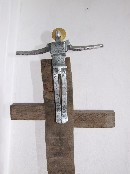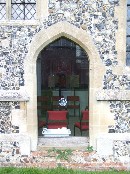| |
|
 |
|
What a delightful church
this is, and how rarely visited! Most
people seek out the famous Poley church
at neighbouring Boxted,
but I prefer here. East Anglia has plenty
of pretty villages, but few of them are
as lovely as Hartest, I think. And yet it
is not a well-known place. Tourist
favourites like Kersey and Heydon are
undoubtedly attractive, but they do not
measure up to this sprawling old village
set around its green in a secretive fold
in the hills. In truth, south-west
Suffolk is perhaps the least-visited part
of East Anglia, and yet it is in many
ways quite the loveliest. Hartest
feels like a place where you could live
quite happily without leaving it too
often. It still has shops, a decent pub
and even a social hall that serves as a
cinema and theatre for travelling
companies. It is far enough away from
Bury and Sudbury for the builders of
heartless new estates not to see it as a
natural dormitory village ripe for
development. The brutal out-of-town
shopping centres are far enough away for
all but the 4x4 crowd to resist.
|
The
church is a pretty thing, relaxing in a secluded
graveyard on the edge of the green. Perhaps it is
not one of Suffolk's more interesting or
important medieval survivals, but if that keeps
Hartest out of the guidebooks then all is well
and good. The 14th century tower top collapsed
into the church during the Commonwealth, making
this restoration one of the earliest in Suffolk.
The interior was rebuilt lower, and a new roof
was put on. Several windows and other features
were reused. The curiously shaped nave (it seems wider than it is
long) was reroofed again in the 19th century,
when the font was also new. There is a good
collection of interesting and restrained
memorials, including one by Henry Westmacott,
younger brother of the more famous Richard, which
ripples like a sail.
The
Victorians reordered and refurbished the Lady
Chapel to the chancel, restoring
it to use, but more recently this has been
beautifully redone again. The priest door has
been replaced by glass, with plastic stick-on
'stained glass' - this actually looks rather
good, but it would be nice to see a more
permanent feature - it was there when I visited
eight years ago. I love churches filled with
light. I love the way the lady chapel here seems
to glow with it. At the entrance beside it is a
fine modern interpretation of the crucifixion.
| A little story to finish
with. Coming back here in 2008, I found
that I did not remember much about the
church at all, and so I took more than my
usual time wandering around the outside
figuring out the architectural sequence,
and then inside poking my nose into
corners in a knowing manner. I had been
inside about fifteen minutes when the
churchwarden came in to speak to me. He
was very polite and very charming, but he
made it clear that he wanted to know who
I was and what I was doing. It turned out
that this was because there had been a
spate of thefts in the area of roofing
lead. Now, as I was on my bike I was
unlikely to be rolling it up and taking
it away, but he pointed out quite
reasonably that I could have been on some
sort of reconnaisance mission. We
chatted for a while about the
responsibility of being a church warden,
and then he wandered off, leaving me in
peace. Thank goodness that lead thefts
don't give churchwardens a reason to
start locking their churches! This is
such a lovely village it would seem very
strange, and very sad, not to find its
church open and welcoming.
|
|
 |
|
|
|

